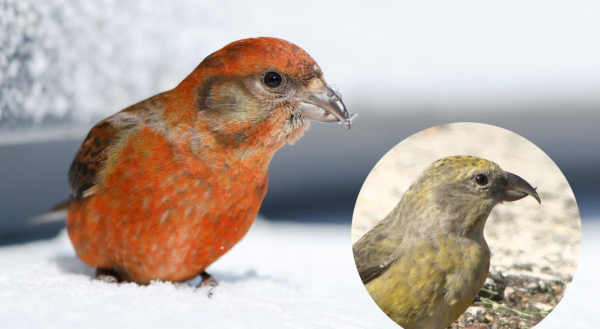
Evening Grosbeaks are already providing surprise visits to many feeding stations and winter water features as far south as Tennessee and Alabama (photo by Stan Vuxinic).

Anyone would be thrilled to see Pine Grosbeaks mobbing their black-oil sunflower feeder.

Red Crossbills are another of the exciting “winter finches” being monitored during this year’s winter finch invasion (male crossbill photo by Neil Paprocki; female photo by Aaron Brees).
|
Now that you have your feeders stocked and ready for “winter finches” to appear, according to a new article that’s hot off the “electronic presses” of the American Birding Association (ABA), feeding stations in many areas are already experiencing some exciting visits by northern finches, such as Purple Finches, Pine Siskins, Evening Grosbeaks, Pine Grosbeaks, Red Crossbills, White-winged Crossbills, Hoary Redpolls, and Common Redpolls. Perhaps you are already hosting one or more of these species, as this winter’s “invasion” progresses.
Here is an update from the ABA: Birders in the eastern United States and southeastern Canada are reporting a banner year for irruptive boreal birds, including remarkable records and a “super-flight” of finches. Typically, only some of the irruptive finch species found in the East will undergo an irruption, but in super-flight years, the search for food drives representatives of all 8 species south, An enormous movement of northern finches was recorded from in late summer into fall at migration hotspots like the Tadoussac Bird Observatory in Quebec, Cape May in New Jersey, and Hawk Ridge in Duluth, Minnesota. By mid-fall, a Common Redpoll made it to Albuquerque, New Mexico; Evening Grosbeaks were spotted in the Florida Panhandle; Pine Siskins were reported in northern Mexico and into the Atlantic to Bermuda; and Hoary Redpolls visited Cleveland, Ohio.
These birds rely on the seed production (masting) cycles of trees in the core of their ranges. Entire populations of trees will synchronously produce millions seeds some years, but produce no seeds other years. Irruptive “finch” movements follow these seed cycles, but birders in the United States usually don’t see many finches in years when there is food in the boreal forest. Southward movements correspond with years of mast failure, when these birds must search for alternate foods, including seeds of ornamental plants and well-stocked bird feeders. The latter are particularly popular with Pine Siskins, Purple Finches, Evening Grosbeaks, and Common Redpolls.
The Fall of 2020’s super-flight corresponds with strongly favorable “winter-spring” 2020 nesting conditions. Spruce trees produced ample seed cones for White-winged Crossbills, Pine Siskins, and some Red Crossbills in northeast North America, leading to high nesting success in the area. After the food supply was consumed, these birds moved southward into an excellent white pine seed crop in southern parts of northeastern states.
Meanwhile, Ontario and Quebec are experiencing one of the most intense spruce budworm outbreaks since the one that peaked in the 1970s and ‘80s, which led to booms during the nesting season in populations of Evening Grosbeaks, Purple Finches, and to a lesser extent Pine Siskins and other finches.
Evening Grosbeaks are undergoing their largest invasion in more than 20 years. During fall migration, birders may have noticed elevated numbers of Bay-breasted, Cape May, and Tennessee Warblers; these three species are linked to spruce budworm outbreaks. Common and Hoary Redpolls likely depleted a stock of bog birch seeds, then faced a lack of white birch and yellow birch seeds in the boreal forest, forcing the farther south. The movement of Common Redpolls in the east is perhaps the largest in about a decade. Meanwhile, banding operations at Tadoussac, Quebec reported higher-than-average proportions of adult Pine Grosbeaks, hinting at poor nesting success due to a lack of fruit. Pine Grosbeaks are already being seen as far south as southern New York and Connecticut.
As noted in a recent Field Ornithology article, the West is also getting in on some of the finch invasion fun, and the Finch Research Network continues to report about which finch species are moving when and where. Pine Siskins have moved south on a broadly continental front, and White-winged Crossbills and Common Redpolls have now started to move into the northwest and southern Rocky Mountain states, in addition to the eastern states. Evening Grosbeaks have pushed into parts of the Western half of the United States including Texas, and Red Crossbills are being found in perhaps unprecedented numbers along the West Coast.
There’s still a lot of mystery to be unraveled about these finch invasions due to the inaccessibility of boreal habitats, so this winter offers the best opportunity for many North American birders to appreciate and study these birds. If you come across Red Crossbills or Evening Grosbeaks, please try to grab audio recordings and upload them to eBird, which helps biologists determine which “Type” they belong to and where they are showing up. Meanwhile, the Finch Research Network will continue to study and analyze the movements and behavior of these finches to produce even better Winter Finch Forecasts and raise awareness of finch movements overall.
This information was gleaned from an excellent ABA Field Ornithology article authored by Matt Young and Ryan Mandelbaum, which you can refer to at https://www.aba.org/a-superflight-of-finches-in-the-east/